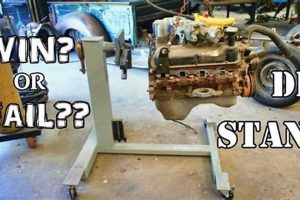A self-constructed platform designed to support a table saw, offering stability and often incorporating features such as mobility, storage, and improved ergonomics, enhances the functionality and usability of the power tool. These custom-built structures can be tailored to specific user needs and workshop environments. For example, a woodworker might construct a mobile base with integrated drawers for blade storage.
The utility of such a base lies in its ability to improve safety, accuracy, and efficiency when operating a table saw. A stable and appropriately sized platform minimizes vibration and reduces the risk of accidents. Integrated storage solutions declutter the workspace, while mobility allows for easy repositioning of the saw within the shop. Historically, woodworkers often built their own bases to optimize their workflow and adapt to space constraints.
This article will delve into the considerations for designing and constructing a sturdy and functional base, exploring different types of designs, material selection, and essential features to incorporate for optimal performance and longevity. Subsequent sections will provide practical guidance on building a custom base, covering key aspects from initial planning to final assembly.
Essential Considerations for Fabricating a Table Saw Support
The creation of a custom platform for a table saw requires careful planning and execution to ensure stability, functionality, and safety. These tips offer guidance for achieving optimal results.
Tip 1: Prioritize a Solid Foundation: A stable base is paramount. Select materials and construction methods that minimize vibration and prevent movement during operation. Consider a robust frame of steel or reinforced wood for maximum rigidity.
Tip 2: Account for Table Saw Dimensions: Measure the saw’s footprint accurately to ensure the support structure provides adequate surface area. Allow for overhang or extensions if planning to incorporate outfeed support or auxiliary tables.
Tip 3: Integrate Dust Collection Capabilities: Incorporate a dust collection port or enclosure beneath the saw table to mitigate airborne particles. This improves air quality and maintains a cleaner workspace. Ensure compatibility with existing dust collection systems.
Tip 4: Optimize Ergonomics: Design the platform to position the saw table at a comfortable working height. Reducing strain and fatigue improves accuracy and prevents injuries. Consider adjustable height options for versatility.
Tip 5: Plan for Mobility: If portability is desired, use heavy-duty casters with locking mechanisms. Ensure the casters are rated to support the combined weight of the saw and the support structure. Consider placement for balanced weight distribution.
Tip 6: Incorporate Storage Solutions: Integrate drawers, shelves, or compartments to store blades, tools, and accessories. Organized storage enhances efficiency and minimizes clutter. Ensure storage compartments do not compromise the structural integrity of the platform.
Tip 7: Reinforce Critical Joints: Use durable fasteners, such as bolts and screws, and reinforce joints with gussets or metal plates. This increases the overall strength and longevity of the support structure. Regularly inspect joints for signs of wear or loosening.
Adherence to these guidelines contributes to the creation of a safe, efficient, and customized table saw workstation. Proper execution maximizes the utility of the power tool and enhances the overall woodworking experience.
The subsequent sections will provide detailed instructions on various designs, material selection, and assembly techniques to further guide the construction process.
1. Stability
Stability is paramount in the design and construction of a support platform for a table saw. The rigidity of the base directly influences the accuracy and safety of cuts. An unstable base can cause the saw to vibrate, leading to inaccurate cuts, increased blade wear, and a higher risk of kickback. For instance, a frame constructed from thin, unreinforced wood is likely to flex during operation, compromising cut quality. This instability transmits to the workpiece, potentially causing the blade to bind or wander. A solid, stable foundation is thus a prerequisite for safe and precise woodworking.
The cause-and-effect relationship between base stability and cut quality is readily observable. A stable support structure minimizes vibration, allowing for smoother blade operation and cleaner cut edges. Examples of stable designs include welded steel frames or robust wooden structures with cross-bracing. Conversely, platforms with loose joints or inadequate support members will exhibit noticeable vibration, resulting in rough cuts and potential safety hazards. The addition of weight and a wide footprint can further enhance stability, particularly when working with larger workpieces. The practical significance of understanding this connection lies in the ability to make informed design and material choices that prioritize structural integrity.
In conclusion, stability is not merely a desirable attribute but a fundamental requirement for a functional table saw platform. Choosing appropriate materials and employing sound construction techniques are essential for achieving a rigid and stable base. This, in turn, improves cut accuracy, extends the life of the saw blade, and significantly enhances operator safety. Ignoring stability compromises the entire woodworking operation.
2. Mobility
Mobility represents a critical consideration in the design and utility of a self-constructed table saw platform. The ability to reposition the saw within a workshop enhances flexibility and optimizes workflow, particularly in environments with limited space.
- Caster Selection and Load Capacity
The selection of appropriate casters is paramount to ensure safe and effective movement. Casters must be rated to support the combined weight of the table saw and the platform, including the added weight of stored materials. Undersized casters can fail, leading to instability and potential injury. Locking mechanisms are essential to prevent unintended movement during operation. Industrial-grade casters with robust braking systems are recommended for heavier saws.
- Wheel Type and Floor Surface
The type of wheel material influences the ease of movement across different floor surfaces. Harder wheels, such as those made of steel or polyurethane, are suitable for smooth concrete floors but may be noisy and less effective on uneven surfaces. Softer rubber wheels provide better grip and reduce noise but may wear more quickly. Consideration of the workshop floor is necessary to choose the appropriate wheel type.
- Placement and Weight Distribution
Strategic caster placement is crucial for balanced weight distribution. Casters positioned at the corners of the platform provide maximum stability and prevent tipping. For larger platforms, additional casters may be necessary in the center to distribute weight evenly. Uneven weight distribution can make the platform difficult to maneuver and increase the risk of instability.
- Handle and Leverage
The addition of a handle or lever can facilitate easier movement, particularly for heavier platforms. A well-positioned handle provides leverage and allows for more controlled maneuvering. The handle should be ergonomically designed to minimize strain on the user. Consider a removable handle to reduce interference when the platform is in a stationary position.
The integration of mobility into a platform design transforms a stationary tool into a versatile workstation. Through careful caster selection, strategic placement, and the inclusion of leverage mechanisms, the platform can be easily adapted to varying workspace needs, enhancing overall efficiency and productivity. The balance between mobility and stability remains central to the design process.
3. Storage
Incorporating storage solutions into the design of a self-constructed table saw platform directly addresses the need for efficient organization and accessibility of tools and accessories, contributing to a more streamlined and productive woodworking process.
- Blade Organization and Protection
Dedicated storage compartments for saw blades safeguard delicate cutting edges from damage. Vertical slots or individual drawers prevent blades from rubbing against each other, maintaining sharpness and extending lifespan. Clearly labeled storage allows for quick identification and retrieval of the appropriate blade for a specific task. For instance, storing blades within a closed drawer protects them from dust and humidity, preserving their cutting performance.
- Tool Accessibility and Workflow Efficiency
Integrated storage for essential tools, such as push sticks, wrenches, and measuring devices, eliminates the need to search for these items before each operation. Strategically positioned drawers or shelves keep frequently used tools within easy reach, minimizing downtime and improving workflow. An example would be a small drawer located directly beneath the saw table to hold push sticks and blade wrenches, enabling immediate access when needed.
- Dust Collection Accessory Management
Storage solutions can accommodate dust collection hoses, fittings, and adapters, preventing clutter and ensuring these components are readily available for connection. Dedicated hooks or compartments can prevent hoses from becoming tangled or damaged. A practical example involves a designated space for storing a shop vacuum hose and associated attachments directly beneath the table saw platform, streamlining the dust collection process.
- Material and Jig Storage
Larger storage areas can be designed to hold offcuts, jigs, or work-holding devices, optimizing space utilization and reducing clutter within the workshop. Shelves or cabinets beneath the table saw platform can provide convenient storage for frequently used materials or custom-built jigs. For example, a shallow drawer could house various feather boards and miter gauges, keeping them accessible for repeated use.
The integration of these storage facets into a self-made table saw platform not only promotes organization and accessibility but also contributes to a safer and more efficient woodworking environment. The thoughtful design of storage solutions enhances the overall usability and practicality of the platform, maximizing its value within the workshop.
4. Ergonomics
Ergonomics represents a critical, often underestimated, component of a self-constructed platform for a table saw. The inherent design of the platform dictates the operator’s posture, reach, and overall physical strain during operation. An improperly designed platform can lead to discomfort, fatigue, and, over time, musculoskeletal disorders. The height of the saw table relative to the operator’s stature is a prime example; a table that is too low necessitates constant bending, stressing the lower back, while a table that is too high forces the operator to raise their shoulders, leading to neck and shoulder pain. These seemingly minor inconveniences can cumulatively contribute to chronic health issues. The causal link between poor ergonomic design and operator well-being is well-documented in occupational health studies.
The practical application of ergonomic principles in the platform’s design involves several key considerations. Foremost is determining the optimal table height. This can be achieved by measuring the operator’s elbow height while standing and adjusting the platform’s height accordingly. Providing sufficient knee clearance beneath the platform allows for a more natural and comfortable stance. The inclusion of features like adjustable-height supports or anti-fatigue mats can further enhance operator comfort. Furthermore, the positioning of controls and accessories should be carefully considered to minimize unnecessary reaching or twisting. For example, locating the power switch within easy reach reduces the need to lean awkwardly, promoting safer operation. Incorporating a footrest can alleviate pressure on the lower back during extended periods of use.
In summary, ergonomics is not merely an add-on feature but an integral design consideration for a self-made table saw platform. Prioritizing ergonomic principles, such as proper table height and accessible controls, mitigates the risk of physical strain and promotes long-term operator well-being. The challenge lies in tailoring the platform’s design to the specific needs and physical characteristics of the individual user. By addressing these ergonomic factors, the platform transforms from a mere support structure into a user-centered workstation, enhancing both productivity and safety within the woodworking environment.
5. Dust Collection
Effective dust management is inextricably linked to the design and construction of a self-made table saw platform. The process of cutting wood generates fine particulate matter, posing health risks to the operator through inhalation. The integration of efficient dust collection mechanisms into the platform mitigates these risks, safeguarding respiratory health and contributing to a cleaner, safer working environment. The absence of such measures can lead to the accumulation of dust, increasing the risk of respiratory ailments, reduced visibility, and fire hazards. Thus, dust collection is not an optional add-on but a fundamental safety requirement.
Several practical approaches facilitate dust collection within a custom-built table saw platform. Enclosing the area beneath the saw table creates a collection chamber, preventing dust from dispersing freely. Integrating a dust port, sized appropriately for connection to a shop vacuum or dust collection system, enables the extraction of airborne particles at their source. Examples include constructing a plywood enclosure with a 4-inch dust port, strategically positioned to capture dust expelled from the blade area. Additional measures involve implementing internal baffles within the enclosure to direct airflow towards the dust port, maximizing collection efficiency. Furthermore, sealing any gaps or cracks in the enclosure prevents dust leakage, ensuring optimal performance of the dust collection system.
In conclusion, dust collection is an indispensable component of any well-designed platform for a table saw. The incorporation of appropriate dust control measures is not merely a matter of convenience but a crucial safeguard for operator health and safety. Investing in efficient dust collection solutions is an investment in a cleaner, healthier, and more productive woodworking environment. The long-term benefits of dust mitigation far outweigh the initial effort and expense involved in integrating these systems into the platform’s design and construction.
6. Material Choice
Material selection is a foundational element in the creation of a self-constructed platform for a table saw. The chosen material directly impacts the stability, durability, and overall lifespan of the structure, influencing its capacity to safely and effectively support the power tool.
- Steel Framing and Rigidity
The use of steel as a primary framing material provides exceptional rigidity and load-bearing capacity. Steel platforms resist deflection under the weight of the saw and workpiece, ensuring accuracy during cutting operations. Welded steel frames offer superior strength compared to mechanically fastened alternatives. For instance, a square steel tube frame with welded joints provides a stable and vibration-dampening base for the saw. The drawback is the need for welding equipment and associated skills.
- Wood Construction and Dampening Properties
Wood, particularly hardwoods like maple or oak, offers a balance of strength, workability, and vibration dampening. Wood platforms can be constructed using readily available tools and fasteners. Laminated wood structures, such as plywood or MDF, provide dimensional stability and resistance to warping. An example includes a platform constructed from multiple layers of plywood glued and screwed together, creating a solid and stable base. However, wood is susceptible to moisture damage and may require sealing or painting for protection.
- Composite Materials and Weight Considerations
Composite materials, such as phenolic resin panels or fiber-reinforced polymers, offer a lightweight yet durable alternative. These materials are resistant to moisture and chemicals, making them suitable for demanding workshop environments. Composite panels can be used for the platform’s surface, providing a smooth and stable work area. For example, a phenolic resin panel bolted to a steel frame combines the strength of steel with the durability and weight advantages of composites. However, these materials may be more expensive and require specialized cutting tools.
- Fastener Selection and Joint Integrity
The choice of fasteners significantly impacts the overall strength and stability of the platform. Bolts and screws provide a secure mechanical connection, while adhesives offer additional bonding strength. High-quality fasteners, such as grade 8 bolts or structural screws, are essential for ensuring joint integrity. For example, using lag bolts to secure a wooden frame to a concrete floor provides a stable and vibration-resistant connection. The appropriate selection of fasteners, coupled with proper installation techniques, is crucial for maintaining the structural integrity of the platform over time.
In summary, the selection of materials for a self-made table saw platform involves a careful evaluation of factors such as strength, durability, workability, and cost. The optimal choice depends on the intended use of the platform, the available tools and skills, and the specific environmental conditions of the workshop. By considering these factors, constructors can create a platform that provides a safe, stable, and long-lasting foundation for their table saw.
Frequently Asked Questions
The following section addresses common inquiries and considerations regarding the construction of a self-made support platform for a table saw. The information aims to provide clarity and guidance for individuals undertaking this project.
Question 1: What is the minimum acceptable material thickness for a wooden support platform?
The minimum acceptable material thickness depends on the wood species and the overall design. As a general guideline, plywood should be at least inch thick, and solid wood should be at least 1 inches thick. Thicker materials provide greater stability and resistance to deflection.
Question 2: Is welding experience necessary for constructing a steel support platform?
Welding experience is highly recommended for steel platform construction. Welding creates strong and durable joints, essential for the structural integrity of the platform. Alternatives, such as bolting steel components together, can be employed, but may compromise stability.
Question 3: How should caster load capacity be calculated?
Caster load capacity must exceed the combined weight of the table saw, the platform, and any stored materials. It is prudent to add a safety factor of at least 25% to account for dynamic loads and uneven weight distribution. Consult caster manufacturer specifications for accurate load ratings.
Question 4: What are the risks associated with inadequate dust collection?
Inadequate dust collection poses significant health risks, including respiratory irritation, allergic reactions, and long-term lung damage. Wood dust is also a known carcinogen. Furthermore, accumulated dust creates a fire hazard and reduces visibility within the workspace.
Question 5: How can vibration be minimized in a support platform?
Vibration can be minimized through the use of dense materials, rigid construction techniques, and strategic dampening measures. Steel framing, solid wood construction, and the incorporation of rubber feet or vibration-absorbing pads can effectively reduce vibration transmission.
Question 6: What safety precautions should be observed during platform construction?
Appropriate safety precautions must be observed throughout the construction process. These include wearing safety glasses, hearing protection, and respiratory protection when cutting or welding materials. Power tools must be used in accordance with manufacturer instructions, and all electrical connections must be properly grounded.
The foregoing answers offer a concise overview of critical considerations for building a support platform. Prioritization of safety, stability, and appropriate material selection remains paramount.
The subsequent article sections will address specific design options and construction techniques in greater detail.
Conclusion
This exploration of the self-made platform for table saws has underscored the critical factors influencing its functionality and safety. The necessity of stability, facilitated by robust material selection and construction methods, was emphasized. The integration of mobility, storage, ergonomics, and effective dust collection systems contributes to a more efficient and safer woodworking environment. Each design choice, from caster selection to storage compartment placement, directly impacts the overall performance and usability of the platform.
The construction of a stable and thoughtfully designed table saw platform warrants careful planning and execution. The pursuit of optimal support and utility, coupled with a commitment to safety protocols, will result in a workstation that enhances the woodworking experience and contributes to the creation of quality projects. Continued adherence to best practices and diligent maintenance will ensure the longevity and reliability of the self-constructed support for years to come.



![Build a DIY Vertical Bike Stand Today! [Plans & Guide] The DIY Hub: Creative Crafts, Repairs & Life Hacks Build a DIY Vertical Bike Stand Today! [Plans & Guide] | The DIY Hub: Creative Crafts, Repairs & Life Hacks](https://craftingdiycenter.com/wp-content/uploads/2025/07/th-3321-300x200.jpg)



